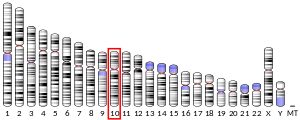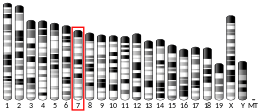Dock180
Dock180, (Dedicator of cytokinesis) also known as DOCK1, is a large (~180 kDa) protein involved in intracellular signalling networks.[5] It is the mammalian ortholog of the C. elegans protein CED-5 and belongs to the DOCK family of Guanine nucleotide exchange factors (GEFs).[6]
Discovery
Dock180 was identified, using a far-western blotting approach, as a binding partner of the adaptor protein Crk that was able to induce morphological changes in 3T3 fibroblasts.[7] Subsequently it was reported that Dock180 was able to activate the small GTP-binding protein (G protein) Rac1[8] and this was later shown to happen via its ability to act as a GEF.[9]
Structure and function
Dock180 is part of a large class of proteins (GEFs) which contribute to cellular signalling events by activating small G proteins. In their resting state G proteins are bound to Guanosine diphosphate (GDP) and their activation requires the dissociation of GDP and binding of guanosine triphosphate (GTP). GEFs activate G proteins by promoting this nucleotide exchange.
Dock180 and related proteins differ from other GEFs in that they do not possess the canonical structure of tandem DH-PH domains known to elicit nucleotide exchange. Instead they possess a DHR2 domain which mediates Rac activation by stabilising it in its nucleotide-free state.[9] Dock180-related proteins also possess a DHR1 domain which has been shown, in vitro, to bind phospholipids[10] and which may be involved in their interaction with cellular membranes. Other structural features of Dock180 include an N-terminal SH3 domain involved in binding to ELMO proteins (see below)[11] and a C-terminal proline-rich region which, in Myoblast city (the Drosophila melanogaster ortholog of Dock180), was shown to bind DCrk (the Drosophila ortholog of Crk).[12]
Regulation of Dock180 Activity
Under physiological conditions Dock180 alone is inefficient at promoting nucleotide exchange on Rac.[11] Effective GEF activity requires an interaction between Dock180 and its binding partner ELMO. ELMO1 is the most comprehensively described isoform of this small family of non-catalytically active proteins which function to recruit Dock180 to the plasma membrane and induce conformational changes which increase GEF efficiency.[13][14][15] ELMO1 has also been reported to inhibit ubiqitinylation of Dock180 and so prevent its degradation by proteasomes.[16] Receptor-mediated activation of RhoG (a small G protein of the Rac subfamily) is perhaps the best known inducer of Dock180 GEF activity. Active (GTP-bound) RhoG recruits the ELMO/Dock180 complex to the plasma membrane thereby bringing Dock180 into contact with its substrate, Rac.[17] In tumour cells Dock180 is regulated by a complex containing Crk and p130Cas which is in turn regulated by cooperative signalling by β3-containing integrin complexes and the membrane-bound protein uPAR.[18]
Signalling Downstream of Dock180
Dock180 is a Rac-specific GEF and so is responsible for a subset of Rac-specific signalling events. These include cell migration and phagocytosis of apoptotic cells in C. elegans,[19] neurite outgrowth in PC12 cells[20] and myoblast fusion in the Zebrafish embryo.[21] More recently the DHR1 domain of Dock180 was shown to bind SNX5 (a sorting nexin) and this interaction promoted retrograde transport of the cation-independent mannose 6-phosphate receptor to the Trans-Golgi Network in a Rac-independent manner.[22] Increased expression of Dock180 and Elmo has been reported to contribute to glioma invasion.[23]
Interactions
Dock180 has been shown to interact with:
References
- GRCh38: Ensembl release 89: ENSG00000150760 - Ensembl, May 2017
- GRCm38: Ensembl release 89: ENSMUSG00000058325 - Ensembl, May 2017
- "Human PubMed Reference:". National Center for Biotechnology Information, U.S. National Library of Medicine.
- "Mouse PubMed Reference:". National Center for Biotechnology Information, U.S. National Library of Medicine.
- "Entrez Gene: DOCK1 dedicator of cytokinesis 1".
- Meller N, Merlot S, Guda C (November 2005). "CZH proteins: a new family of Rho-GEFs". J. Cell Sci. 118 (Pt 21): 4937–46. doi:10.1242/jcs.02671. PMID 16254241.
- Hasegawa H, Kiyokawa E, Tanaka S, et al. (April 1996). "DOCK180, a major CRK-binding protein, alters cell morphology upon translocation to the cell membrane". Mol. Cell. Biol. 16 (4): 1770–76. doi:10.1128/mcb.16.4.1770. PMC 231163. PMID 8657152.
- Kiyokawa E, Hashimoto Y, Kobayashi S, et al. (November 1998). "Activation of Rac1 by a Crk SH3-binding protein, DOCK180". Genes Dev. 12 (21): 3331–36. doi:10.1101/gad.12.21.3331. PMC 317231. PMID 9808620.
- Côté JF, Vuori K (December 2002). "Identification of an evolutionarily conserved superfamily of DOCK180-related proteins with guanine nucleotide exchange activity". J. Cell Sci. 115 (Pt 24): 4901–13. doi:10.1242/jcs.00219. PMID 12432077.
- Côté JF, Motoyama AB, Bush JA, et al. (August 2005). "A novel and evolutionarily conserved PtdIns(3,4,5)P3-binding domain is necessary for DOCK180 signaling". Nat. Cell Biol. 7 (8): 797–807. doi:10.1038/ncb1280. PMC 1352170. PMID 16025104.
- Brugnera E, Haney L, Grimsley C, et al. (August 2002). "Unconventional Rac-GEF activity is mediated through the Dock180-ELMO complex". Nat. Cell Biol. 4 (8): 574–82. doi:10.1038/ncb824. PMID 12134158.
- Balagopalan L, Chen MH, Geisbrecht ER, et al. (December 2006). "The CDM Superfamily Protein MBC Directs Myoblast Fusion through a Mechanism That Requires Phosphatidylinositol 3,4,5-Triphosphate Binding but Is Independent of Direct Interaction with DCrk". Mol. Cell. Biol. 26 (24): 9442–55. doi:10.1128/MCB.00016-06. PMC 1698515. PMID 17030600.
- Lu M, Ravichandran KS (2006). "Dock180-ELMO cooperation in Rac activation". Meth. Enzymol. Methods in Enzymology. 406: 388–402. doi:10.1016/S0076-6879(06)06028-9. ISBN 9780121828110. PMID 16472672.
- Lu M, Kinchen JM, Rossman KL, et al. (2004). "PH domain of ELMO functions in trans to regulate Rac activation via Dock180". Nature Structural & Molecular Biology. 11 (8): 756–62. doi:10.1038/nsmb800. PMID 15247908.
- Lu M, Kinchen JM, Rossman KL, et al. (February 2005). "A Steric-inhibition model for regulation of nucleotide exchange via the Dock180 family of GEFs". Curr. Biol. 15 (4): 371–77. doi:10.1016/j.cub.2005.01.050. PMID 15723800.
- Makino Y, Tsuda M, Ichihara S, et al. (March 2006). "Elmo1 inhibits ubiquitylation of Dock180". J. Cell Sci. 119 (Pt 5): 923–32. doi:10.1242/jcs.02797. PMID 16495483.
- Katoh H, Negishi M (July 2003). "RhoG activates Rac1 by direct interaction with the Dock180-binding protein Elmo". Nature. 424 (6947): 461–64. doi:10.1038/nature01817. PMID 12879077.
- Smith HW, Marra P, Marshall CJ (August 2008). "uPAR promotes formation of the p130Cas–Crk complex to activate Rac through DOCK180". J. Cell Biol. 182 (4): 777–90. doi:10.1083/jcb.200712050. PMC 2518715. PMID 18725541.
- Gumienny TL, Brugnera E, Tosello-Trampont AC, et al. (October 2001). "CED-12/ELMO, a novel member of the CrkII/Dock180/Rac pathway, is required for phagocytosis and cell migration". Cell. 107 (1): 27–41. doi:10.1016/S0092-8674(01)00520-7. PMID 11595183.
- Katoh H, Yasui H, Yamaguchi Y, et al. (October 2000). "Small GTPase RhoG Is a Key Regulator for Neurite Outgrowth in PC12 Cells". Mol. Cell. Biol. 20 (19): 7378–87. doi:10.1128/MCB.20.19.7378-7387.2000. PMC 86291. PMID 10982854.
- Moore CA, Parkin CA, Bidet Y, et al. (September 2007). "A role for the Myoblast city homologues Dock1 and Dock5 and the adaptor proteins Crk and Crk-like in zebrafish myoblast fusion". Development. 134 (17): 3145–53. doi:10.1242/dev.001214. PMID 17670792.
- Hara S, Kiyokawa E, Iemura SI, et al. (July 2008). "The DHR1 Domain of DOCK180 Binds to SNX5 and Regulates Cation-independent Mannose 6-phosphate Receptor Transport". Mol. Biol. Cell. 19 (9): 3823–35. doi:10.1091/mbc.E08-03-0314. PMC 2526700. PMID 18596235.
- Jarzynka MJ, Hu B, Hui KM, et al. (August 2007). "ELMO1 and Dock180, a Bipartite Rac1 Guanine Nucleotide Exchange Factor, Promote Human Glioma Cell Invasion". Cancer Res. 67 (15): 7203–11. doi:10.1158/0008-5472.CAN-07-0473. PMC 2867339. PMID 17671188.
- Hsia DA, Mitra SK, Hauck CR, Streblow DN, Nelson JA, Ilic D, Huang S, Li E, Nemerow GR, Leng J, Spencer KS, Cheresh DA, Schlaepfer DD (Mar 2003). "Differential regulation of cell motility and invasion by FAK". J. Cell Biol. 160 (5): 753–67. doi:10.1083/jcb.200212114. PMC 2173366. PMID 12615911.
- Hasegawa H, Kiyokawa E, Tanaka S, Nagashima K, Gotoh N, Shibuya M, Kurata T, Matsuda M (Apr 1996). "DOCK180, a major CRK-binding protein, alters cell morphology upon translocation to the cell membrane". Mol. Cell. Biol. 16 (4): 1770–6. doi:10.1128/MCB.16.4.1770. PMC 231163. PMID 8657152.
- Nishihara H, Kobayashi S, Hashimoto Y, Ohba F, Mochizuki N, Kurata T, Nagashima K, Matsuda M (Nov 1999). "Non-adherent cell-specific expression of DOCK2, a member of the human CDM-family proteins". Biochim. Biophys. Acta. 1452 (2): 179–87. doi:10.1016/s0167-4889(99)00133-0. PMID 10559471.
- Gu J, Sumida Y, Sanzen N, Sekiguchi K (Jul 2001). "Laminin-10/11 and fibronectin differentially regulate integrin-dependent Rho and Rac activation via p130(Cas)-CrkII-DOCK180 pathway". J. Biol. Chem. 276 (29): 27090–7. doi:10.1074/jbc.M102284200. PMID 11369773.
- Matsuda M, Ota S, Tanimura R, Nakamura H, Matuoka K, Takenawa T, Nagashima K, Kurata T (Jun 1996). "Interaction between the amino-terminal SH3 domain of CRK and its natural target proteins". J. Biol. Chem. 271 (24): 14468–72. doi:10.1074/jbc.271.24.14468. PMID 8662907.
- Gumienny TL, Brugnera E, Tosello-Trampont AC, Kinchen JM, Haney LB, Nishiwaki K, Walk SF, Nemergut ME, Macara IG, Francis R, Schedl T, Qin Y, Van Aelst L, Hengartner MO, Ravichandran KS (Oct 2001). "CED-12/ELMO, a novel member of the CrkII/Dock180/Rac pathway, is required for phagocytosis and cell migration". Cell. 107 (1): 27–41. doi:10.1016/s0092-8674(01)00520-7. PMID 11595183.
- Brugnera E, Haney L, Grimsley C, Lu M, Walk SF, Tosello-Trampont AC, Macara IG, Madhani H, Fink GR, Ravichandran KS (Aug 2002). "Unconventional Rac-GEF activity is mediated through the Dock180-ELMO complex". Nat. Cell Biol. 4 (8): 574–82. doi:10.1038/ncb824. PMID 12134158.
Further reading
- Takai S, Hasegawa H, Kiyokawa E, et al. (1996). "Chromosomal mapping of the gene encoding DOCK180, a major Crk-binding protein, to 10q26.13-q26.3 by fluorescence in situ hybridization". Genomics. 35 (2): 403–4. doi:10.1006/geno.1996.0378. PMID 8661160.
- Côté JF, Vuori K (2007). "GEF what? Dock180 and related proteins help Rac to polarize cells in new ways". Trends Cell Biol. 17 (8): 383–93. doi:10.1016/j.tcb.2007.05.001. PMC 2887429. PMID 17765544.
- Komander D, Patel M, Laurin M, et al. (2008). "An α-Helical Extension of the ELMO1 Pleckstrin Homology Domain Mediates Direct Interaction to DOCK180 and Is Critical in Rac Signaling". Mol. Biol. Cell. 19 (11): 4837–51. doi:10.1091/mbc.E08-04-0345. PMC 2575150. PMID 18768751.
- Henson PM (2005). "Engulfment: ingestion and migration with Rac, Rho and TRIO". Curr. Biol. 15 (1): R29–30. doi:10.1016/j.cub.2004.12.017. PMID 15649349.
- deBakker CD, Haney LB, Kinchen JM, et al. (2004). "Phagocytosis of apoptotic cells is regulated by a UNC-73/TRIO-MIG-2/RhoG signaling module and armadillo repeats of CED-12/ELMO". Curr. Biol. 14 (24): 2208–16. doi:10.1016/j.cub.2004.12.029. PMID 15620647.
- Yin J, Haney L, Walk S, et al. (2004). "Nuclear localization of the DOCK180/ELMO complex". Arch. Biochem. Biophys. 429 (1): 23–29. doi:10.1016/j.abb.2004.05.014. PMID 15288806.
- Matsuda M, Ota S, Tanimura R, et al. (1996). "Interaction between the amino-terminal SH3 domain of CRK and its natural target proteins". J. Biol. Chem. 271 (24): 14468–72. doi:10.1074/jbc.271.24.14468. PMID 8662907.
- Savill J (1998). "Apoptosis. Phagocytic docking without shocking". Nature. 392 (6675): 442–3. doi:10.1038/33025. PMID 9548247.
- Wu YC, Horvitz HR (1998). "C. elegans phagocytosis and cell-migration protein CED-5 is similar to human DOCK180". Nature. 392 (6675): 501–4. doi:10.1038/33163. PMID 9548255.
- Albert ML, Kim JI, Birge RB (2001). "alphavbeta5 integrin recruits the CrkII-Dock180-rac1 complex for phagocytosis of apoptotic cells". Nat. Cell Biol. 2 (12): 899–905. doi:10.1038/35046549. PMID 11146654.
- Kobayashi S, Shirai T, Kiyokawa E, et al. (2001). "Membrane recruitment of DOCK180 by binding to PtdIns(3,4,5)P3". Biochem. J. 354 (Pt 1): 73–8. doi:10.1042/0264-6021:3540073. PMC 1221630. PMID 11171081.
- Tu Y, Kucik DF, Wu C (2001). "Identification and kinetic analysis of the interaction between Nck-2 and DOCK180". FEBS Lett. 491 (3): 193–9. doi:10.1016/S0014-5793(01)02195-0. PMID 11240126.
- Gu J, Sumida Y, Sanzen N, Sekiguchi K (2001). "Laminin-10/11 and fibronectin differentially regulate integrin-dependent Rho and Rac activation via p130(Cas)-CrkII-DOCK180 pathway". J. Biol. Chem. 276 (29): 27090–7. doi:10.1074/jbc.M102284200. PMID 11369773.
- Zhou Z, Caron E, Hartwieg E, et al. (2001). "The C. elegans PH domain protein CED-12 regulates cytoskeletal reorganization via a Rho/Rac GTPase signaling pathway". Dev. Cell. 1 (4): 477–89. doi:10.1016/S1534-5807(01)00058-2. PMID 11703939.
- Grimsley CM, Kinchen JM, Tosello-Trampont AC, et al. (2004). "Dock180 and ELMO1 proteins cooperate to promote evolutionarily conserved Rac-dependent cell migration" (PDF). J. Biol. Chem. 279 (7): 6087–97. doi:10.1074/jbc.M307087200. PMID 14638695.
- Wang X, Wu YC, Fadok VA, et al. (2003). "Cell corpse engulfment mediated by C. elegans phosphatidylserine receptor through CED-5 and CED-12". Science. 302 (5650): 1563–6. doi:10.1126/science.1087641. PMID 14645848.
External links
- DOCK1+protein,+human at the US National Library of Medicine Medical Subject Headings (MeSH)
- DOCK180 Info with links in the Cell Migration Gateway
- Overview of all the structural information available in the PDB for UniProt: Q14185 (Dedicator of cytokinesis protein 1) at the PDBe-KB.



